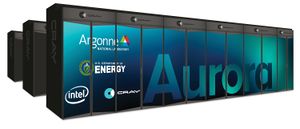(→Overview) |
|||
| (3 intermediate revisions by the same user not shown) | |||
| Line 1: | Line 1: | ||
{{sc title|Aurora}} | {{sc title|Aurora}} | ||
| + | {{supercomputer | ||
| + | |name=Aurora | ||
| + | |image=aurora-sc.jpg | ||
| + | |sponsor=U.S. Department of Energy | ||
| + | |designer=Intel | ||
| + | |designer 2=Cray | ||
| + | |operator=Argonne Leadership Computing Facility | ||
| + | |introduction=2021 | ||
| + | |peak dpflops=>1 exaFLOPS | ||
| + | |price=$600,000,000 | ||
| + | }} | ||
'''Aurora''' is a planned state-of-the-art [[exascale]] [[supercomputer]] designed by Intel/Cray for the [[U.S. Department of Energy]]'s (DOE) [[Argonne Leadership Computing Facility]] (ALCF). The system is expected to become the first supercomputer in the United States to break the exaFLOPS barrier. | '''Aurora''' is a planned state-of-the-art [[exascale]] [[supercomputer]] designed by Intel/Cray for the [[U.S. Department of Energy]]'s (DOE) [[Argonne Leadership Computing Facility]] (ALCF). The system is expected to become the first supercomputer in the United States to break the exaFLOPS barrier. | ||
| Line 32: | Line 43: | ||
| Facility Area || ~3,000 sq. ft. | | Facility Area || ~3,000 sq. ft. | ||
|} | |} | ||
| + | |||
| + | == Overview == | ||
| + | With a price tag of around $600 million, Aurora is slated for 2021 and will reach a peak performance of over 1 exaFLOPS. The computer will feature a future {{intel|Xeon}} processor along with a [[7 nm]]-based Intel Xe GPGPU. | ||
== Documents == | == Documents == | ||
Latest revision as of 10:49, 11 May 2019
| Edit Values | |
| Aurora | |
 | |
| General Info | |
| Sponsors | U.S. Department of Energy |
| Designers | Intel, Cray |
| Operators | Argonne Leadership Computing Facility |
| Introduction | 2021 |
| Peak FLOPS | >1 exaFLOPS |
| Price | $600,000,000 |
Aurora is a planned state-of-the-art exascale supercomputer designed by Intel/Cray for the U.S. Department of Energy's (DOE) Argonne Leadership Computing Facility (ALCF). The system is expected to become the first supercomputer in the United States to break the exaFLOPS barrier.
Contents
History[edit]
Originally announced in April 2015, Aurora was planned to be delivered in 2018 and have a peak performance of 180 petaFLOPS. The system was expected to be the world's most powerful system at the time. The system was intended to be built by Cray based on Intel's 3rd generation Xeon Phi (Knights Hill microarchitecture). In November 2017 Intel announced that Aurora has been shifted to 2021 and will be scaled up to 1 exaFLOPS. The system will likely become the first supercomputer in the United States to break the exaFLOPS barrier. As part of the announcement Knights Hill was canceled and instead be replaced by a "new platform and new microarchitecture specifically designed for exascale".
Original Specifications[edit]
| Original Specs | |
|---|---|
| Computing Power | 180 PFLOPS |
| Compute Nodes | >50,000 |
| Processor | 3rd Generation Intel Xeon Phi (Knights Hill) |
| Memory | >7 PB DRAM and persistent memory |
| Fabric | 2nd Generation Intel Omni-Path Architecture with silicon photonics |
| File System | Intel® Lustre* File System |
| File System Capacity | >150 Petabytes |
| File System Throughput | >1 Terabyte/s |
| Peak Power | 13 MW |
| FLOP/s Per Watt | >13 GigaFLOP/s per watt |
| Facility Area | ~3,000 sq. ft. |
Overview[edit]
With a price tag of around $600 million, Aurora is slated for 2021 and will reach a peak performance of over 1 exaFLOPS. The computer will feature a future Xeon processor along with a 7 nm-based Intel Xe GPGPU.
Documents[edit]
Original System[edit]
- Ushering in a New Era, Argonne National Laboratory’s Aurora System, April 2015
- Aurora Fact Sheet
External links[edit]
References[edit]
- Introducing Aurora, April 9, 2015
- U.S. Department of Energy Selects Intel to Deliver Nation’s Most Powerful Supercomputer at Argonne National Laboratory, April 9, 2015
- Unleashing High-Performance Computing Today and Tomorrow, November 13, 2017
| designer | Intel + and Cray + |
| introductory date | 2021 + |
| main image |  + + |
| name | Aurora + |
| operator | Argonne Leadership Computing Facility + |
| release price | $ 600,000,000.00 (€ 540,000,000.00, £ 486,000,000.00, ¥ 61,998,000,000.00) + |
| sponsor | United States Department of Energy (DOE) + |